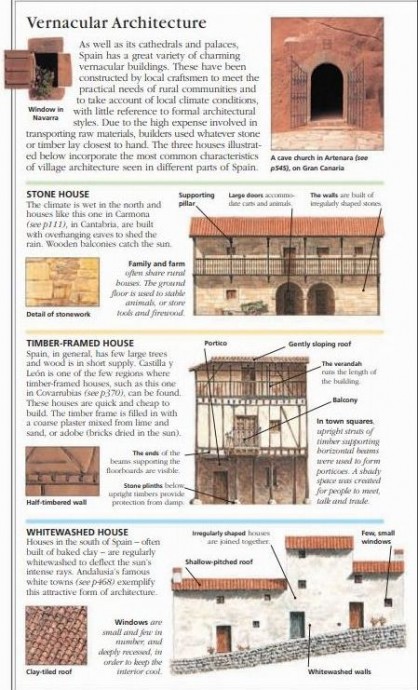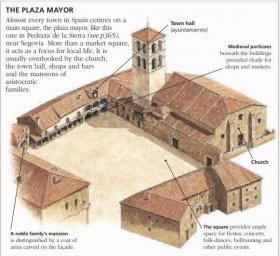Vernacular Architecture
As well as its cathedrals and palaces, Spain has a great variety of charming vernacular buildings. These have been constructed by local craftsmen to meet the practical needs of rural communities and to take account of local climate conditions, with little reference to formal architectural styles. Due to the high expense involved in transporting raw materials, builders used whatever stone or timber lay closest to hand. The three houses illustrated below incorporate the most common characteristics of village architecture seen in different parts of Spain.
A cave church in Artenara, on Gran Canaria
Window in Navarra
STONE HOUSE
The climate is wet in the north and houses like this one in Carmona, in Cantabria, are built with overhanging eaves to shed the rain. Wooden balconies catch the sun.
Family and farm often share rural houses. The ground floor is used to stable animals, or store tools and firewood.
The walls are built of irregularly shaped stones
Large doors accommodate carts and animals
Supporting pillar
Detail of stonework
TIMBER-FRAMED HOUSE
Spain, in general, has few large trees and wood is in short supply. Castilla y León is one of the few regions where timber-framed houses, such as this one in Covarrubias, can be found. These houses are quick and cheap to build. The timber frame is filled in with a coarse plaster mixed from lime and sand, or adobe (bricks dried in the sun).
In town squares, upright struts of timber supporting horizontal beams were used to form porticoes. A shady space was created for people to meet, talk and trade.
Stone plinths below upright timbers provide protection from damp
Portico
The ends of the beams supporting the floorboards are visible
Balcony
The verandah runs the length of the building
Gently sloping roof
Half-timbered wall
WHITEWASHED HOUSE
Houses in the south of Spain – often built of baked clay – are regularly whitewashed to deflect the sun’s intense rays. Andalusia’s famous white towns exemplify this attractive form of architecture.
Windows are small and few in number, and deeply recessed, in order to keep the interior cool.
Few, small windows
Whitewashed walls
Irregularly shaped houses are joined together
Shallow-pitched roof
Clay-tiled roof

THE PLAZA MAYOR
Almost every town in Spain centres on a main square, the plaza mayor, like this one in Pedraza de la Sierra, near Segovia. More than a market square, it acts as a focus for local life. It is usually overlooked by the church, the town hall, shops and bars and the mansions of aristocratic families.
A noble family’s mansion is distinguished by a coat of arms carved on the façade
Medieval porticoes beneath the buildings provided shade for shops and markets
The square provides ample space for fiestas, concerts, folk-dances, bullrunning and other public events
Town hall (ayuntamiento)
Church
RURAL ARCHITECTURE
A variety of distinctive buildings dots the countryside. Where the rock is soft and the climate hot, subterranean dwellings have been excavated. Insulated from extremes of temperature, they provide a comfortable place to live. Hórreos, granaries raised on stone stilts to prevent rats climbing up into the grain, are a common sight in Galicia (where they are stone-built) and Asturias (where they are made of wood). In fields you will often see shelters for livestock or for storing crops, such as the teitos of Asturias. Windmills provided power in parts of Spain where there was little running water but plentiful wind, like La Mancha and the Balearic Islands. Almost everywhere in the Spanish countryside you will come across ermitas, isolated chapels or shrines dedicated to a local saint. An ermita may be opened only on the patron saint’s feast day.
Cave houses in Guadix near Granada
Teito in Valle de Teverga in Asturias
Hórreo, a granary, on the Rías Baixas in Galicia
Windmill above Consuegra in La Mancha
